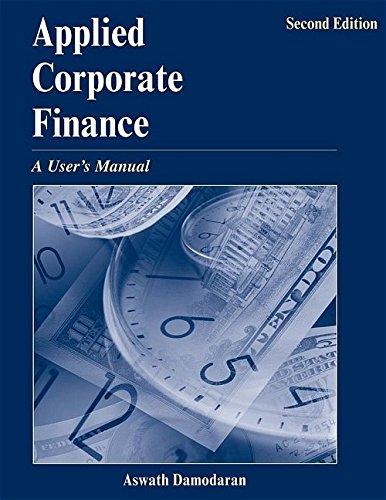To analyze the corporate governance structure of the firm and to assess where the power in the
Question:
To analyze the corporate governance structure of the firm and to assess where the power in the firm lies – with incumbent management or with stockholders in the firm?
Key Questions:
• Is this a company where there is a separation between management and ownership? If so, how responsive is management to stockholders?
• Is there a potential conflict between stockholders and lenders to the firm? If so, how is it managed?
• How does this firm interact with financial markets? How do markets get information about the firm?
• How does this firm view its social obligations and manage its image in society?
Framework for Analysis:
1.
The Chief Executive Officer
• Who is the CEO of the company? How long has he or she been CEO?
• If it is a “family run” company, is the CEO part of the family? If not, what career path did the CEO take to get to the top? (Did he or she come from within the organization or from outside?)
• How much did the CEO make last year? What form did the compensation take? (Salary, bonus and option components)
• How much stock and options in the company does the CEO own?
2.
The Board of Directors
• Who is on the board of directors of the company? How long have they served as directors?
• How many of the directors are “inside” directors?
• How many of the directors have other connections to the firm (as suppliers, clients, customers..)?
• How many of the directors are CEOs of other companies?
• Do any of the directors have large stockholdings or represent those who do?
3.
Bondholder Concerns
• Does the firm have any publicly traded debt?
• Are there are bond covenants (that you can uncover) that have been imposed on the firm as part of the borrowing?
• Do any of the bonds issued by the firm come with special protections against stockholder expropriation?
4.
Financial Market Concerns
• How many analysts follow the firm?
• How much trading volume is there on this stock?
5.
Societal Constraints
• What does the firm say about its social responsibilities?
• Does the firm have a particularly good or bad reputation as a corporate citizen?
• If it does, how has it earned this reputation?
• If the firm has been a recent target of social criticism, how has it responded?
Information Sources:
For firms that are incorporated in the United States, information on the CEO and the board of directors is primarily in the filings made by the firm with the Securities and Exchange Commission. In particular, the 14-DEF will list out the directors in the firm, their relationship with the firm and details on compensation for both directors and top managers. You can also get information on trading done by insiders from the SEC filings.
For firms that are not listed in the United States, this information is much more difficult to obtain. However, the absence of readily accessible information on directors and top management is more revealing about the power that resides with incumbent managers.
Information on a firm’s relationships with bondholders usually resides in the firm’s bond agreements and loan covenants. While this information may not always be available to the public, the presence of constraints shows up indirectly in the firm’s bond ratings and when the firm issues new bonds.
The relationship between firms and financial markets is an uneasy one. The list of analysts following a firm can be obtained from publications such as the Nelson Directory of Securities Research. For larger and more heavily followed firms the archives of financial publications (the Financial Times, Wall Street Journal, Forbes, Barron’s) can be useful sources of information.
Finally, the reputation of a firm as a corporate citizen is the toughest area to obtain clear information on, since it is only the outliers (the worst and the best corporate citizens) that make the news. The proliferation of socially responsible mutual funds, however, does give us a window on those firms that pass the tests (arbitrary, though they sometimes are) imposed by these funds for a firm to be viewed as “socially responsible”.
Step by Step Answer:






